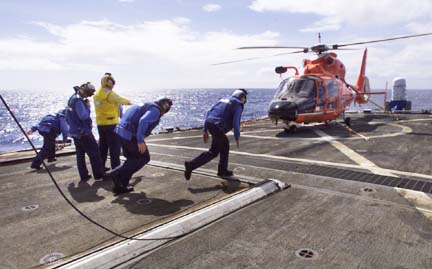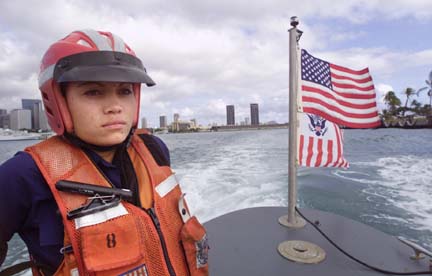


WHEN THE Coast Guard's high-endurance cutter Jarvis pulled out of Sand Island on Sept. 10, its crew of 170 sailors believed it would be just another six-month deployment beginning off the coast of Mexico, where it would perform its prescribed law enforcement and search and rescue missions. CUTTER JARVIS
Alert at sea
The Coast Guard refocuses on
security since the attacksAT YOUR SERVICE
By Gregg K. Kakesako
gkakesako@starbulletin.comBut within a day, Capt. Steven Ratti was back in Hawaii waters. The Jarvis' 76 mm bow cannon, two 25 mm machine guns and one 20 mm Phalanx close-in weapons system on the stern, capable of firing 4,500 rounds per minute, were armed and on alert for terrorists.
At other major ports from New York down the Atlantic Coast and along the Pacific from San Diego northward, the Coast Guard has become an integral part of America's homeland defense.
Its job for the next six months is to patrol security zones established around the Hawaiian Islands following the Sept. 11 hijacking of commercial airlines and the destruction of the twin towers of the World Trade Center in New York and parts of the Pentagon.

Since Sept. 11 the Jarvis, with four FBI agents in tow, boarded a U.S. cargo vessel trying to enter Honolulu Harbor from the West Coast. There were questions concerning its cargo and some of its crew members, Ratti said.The vessel was stopped four miles offshore, and an inspection was conducted by the Coast Guard's marine safety officer and the FBI. No one was detained, however, Ratti said.
Normally, these types of inspections are conducted pier-side, said Cmdr. Bruce Buffer, the Jarvis' executive officer.
"However, because of heightened security," he added, "these checks are now done at sea. This is to prevent anyone with questionable cargo from getting into the harbor."
The Coast Guard here maintains two large 378-foot cutters, like the Jarvis; three 110-foot patrol boats; and one 87-foot vessel. The cutters tend to patrol the waters outside island harbors, with the smaller patrol boats working closer to shore. It also is using its C-130 cargo planes kept at Barbers Point as part of its homeland security patrol force.
Immediately following the Sept. 11 attack, there were concerns that terrorists might seize cargo ships, tankers or even cruise boats and use them as suicide bombs, ramming them into bridges or even Navy warships.

That is why one of the new security regulations that mariners now must abide with is a prohibition that prevents them from coming closer than 100 yards to any Navy vessel. Mariners also must slow down when approaching a Navy warship or facility, throttling down to minimum speed within 500 yards.The Coast Guard also has created a buffer zone around the oil tankers that tie up offshore of Barbers Point and Campbell Industrial Park refineries on the Leeward Coast.
Ratti said that the Coast Guard has always had a law enforcement mission with its drug interdiction, alien immigration patrols and watching out for illegal fishing practices in the Pacific. He acknowledged, however, that since the Sept. 11 incident his crew is in "a higher response posture than in the past. Now vessels are checked more carefully than in the past."
THAT HAS BECOME the case for the nation's 36,000 active-duty Coast Guard members, with about 8,000 stationed here. A few Coast Guard reservists were placed on active duty following the terrorist attacks, but local officials were not able to provide a specific number.
It is obvious that the Coast Guard will need manpower and more funds to continue this mission.
The Coast Guard's current budget for this year is $3.1 billion, but only $73 million is allocated for defense readiness, compared with $1.3 billion earmarked for its law enforcement activities.
It maintains one of the oldest fleets in the Navy, under which it operates during war.
The Jarvis is able to stay at sea for at least 30 days before it needs to be refueled. It is equipped with a flight deck and on deployment is generally accompanied by at least one HH-65A Dolphin helicopter, which has a range of 300 nautical miles.
Some of its youngest crew members have found homeland defense duty a little overwhelming in the beginning.

Seaman Apprentice Ryan Fuller, who enlisted just four months ago, said, "This isn't what I expected, but I would rather be doing this and here protecting the home port."Seaman Roy Long, who has been in the Coast Guard for more than a year, "isn't nervous at all."
"I live in San Diego," Long said. "It's a Navy town, and I have seen what the Coast Guard has been doing. It's what I expected."